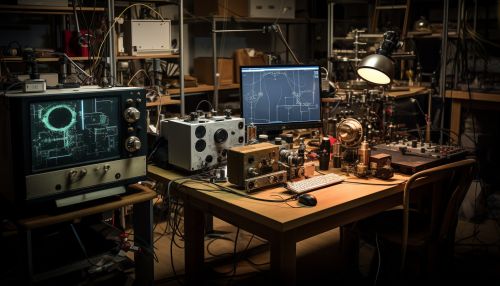Quantum Mechanics and Quantum Communication Physics
Introduction
Quantum mechanics is a fundamental theory in physics that provides a description of the physical properties of nature at the scale of atoms and subatomic particles. It is the foundation of all quantum physics including quantum chemistry, quantum field theory, quantum technology, and quantum information science.
Quantum Mechanics
Quantum mechanics is a branch of physics dealing with physical phenomena at microscopic scales, where the action is on the order of the Planck constant. It departs from classical mechanics primarily at the quantum realm of atomic and subatomic length scales. Quantum mechanics provides a mathematical description of much of the dual particle-like and wave-like behavior and interactions of energy and matter.
Quantum mechanics introduces a critical change to classical physics by asserting that energy is quantized. This means that energy is not continuous, but comes in small but discrete units. The hypothesis that energy is quantized is one of the quantum theories from which quantum mechanics takes its name.
Quantum Communication
Quantum communication is a field of applied quantum physics closely related to quantum information processing and quantum teleportation. Its most interesting application is protecting information channels against eavesdropping by means of quantum cryptography. The most well known and developed application of quantum cryptography is quantum key distribution (QKD). QKD describes the use of quantum communication to establish a secret key between two parties without a third party learning anything about that key, even if this third party can eavesdrop on all communication.
Quantum communication exploits the quantum mechanical properties of particles such as photons to communicate from one location to another. Quantum communication is part of a larger field of study known as quantum information science, which includes quantum computing and quantum cryptography.
Quantum Communication Physics
Quantum communication physics involves the use of quantum mechanics principles to transmit information. The most common method of quantum communication is through the use of quantum entanglement. This is a physical phenomenon that occurs when pairs or groups of particles are generated or interact in ways such that the quantum state of each particle cannot be described independently of the state of the other(s), even when the particles are separated by a large distance.
Quantum entanglement is a fundamental principle of quantum mechanics that has been used to develop technologies such as quantum computing and quantum cryptography. It is also the driving force behind the emerging field of quantum communication.
Quantum Key Distribution
Quantum key distribution (QKD) is a secure communication method which implements a cryptographic protocol involving components of quantum mechanics. It enables two parties to produce a shared random secret key known only to them, which can then be used to encrypt and decrypt messages.
Quantum key distribution is the first and most developed application of quantum cryptography. It takes advantage of the unique properties of quantum mechanics to ensure secure communication by providing security based on the laws of physics, rather than on computational assumptions.


